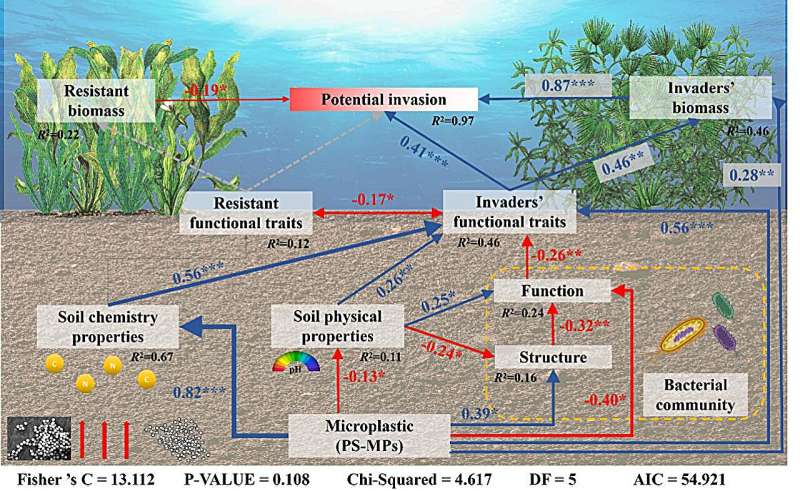This article has been reviewed according to Science X's editorial process and policies. Editors have highlighted the following attributes while ensuring the content's credibility:
fact-checked
peer-reviewed publication
trusted source
proofread
Polystyrene microplastics shown to enhance invasion of exotic submerged macrophytes

Submerged macrophyte invasions and microplastic pollution are major challenges in the context of global change and pose a serious threat to aquatic environments. The presence of microplastics in aquatic ecosystems alters plant function, sediment microbial community structure and ecosystem multifunctionality, but how microplastic pollution affects exotic submerged macrophyte invasions and the mechanisms by which environmental and biological factors play a role are not clear.
Supervised by Prof. Xing Wei, Li Xiaowei, a Ph.D. student from the Wuhan Botanical Garden of the Chinese Academy of Sciences investigated how polystyrene microplastics (PS-MPs) pollution affected the invasion process of exotic submerged macrophytes, as well as the mechanism of the influence of the soil physicochemical property, the microbial structural function, and plant functional traits therein.
The study, titled "Microplastics enhance the invasion of exotic submerged macrophytes by mediating plant functional traits, sediment properties, and microbial communities," is published in the Journal of Hazardous Materials.
According to Li Xiaowei, PS-MPs in sediments significantly increased in the invasiveness of exotic submerged macrophytes, and the biomass of exotic submerged macrophytes gradually increased with the increase of PS-MPs concentration, but not the biomass of native plants.
In addition, PS-MPs in sediments enhanced the expression of key traits of exotic plants, such as specific leaf area and leaf dry matter content, as well as some traits related to material accumulation, i.e., soluble starch, soluble sugars, total plant nitrogen and total carbon contents.
Moreover, the invasion of exotic submerged macrophytes was directly influenced by their functional traits, which were co-regulated by a series of biotic and abiotic factors, among which the effects of soil physicochemical properties and sediment bacterial functions were the most prominent.
Soil physicochemical properties and the amount of PS-MPs were positively correlated with the functional traits of exotic submerged macrophytes, while sediment bacterial function was negatively correlated.
These findings contribute to a deeper understanding of how aquatic ecosystems respond to exotic submerged macrophyte invasion under the influence of MPs pollution, providing valuable insights for mitigating the environmental impact of MPs and ensuring long-term sustainability.
More information: Xiaowei Li et al, Microplastics enhance the invasion of exotic submerged macrophytes by mediating plant functional traits, sediment properties, and microbial communities, Journal of Hazardous Materials (2024). DOI: 10.1016/j.jhazmat.2024.134032
Journal information: Journal of Hazardous Materials
Provided by Chinese Academy of Sciences





















